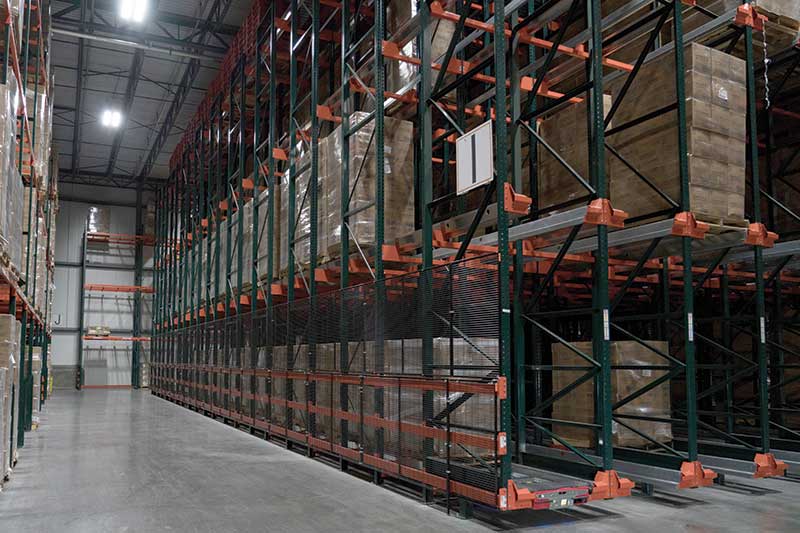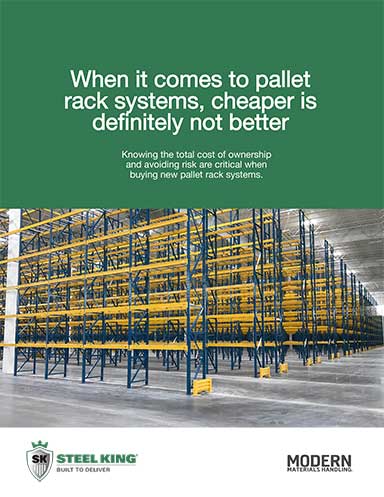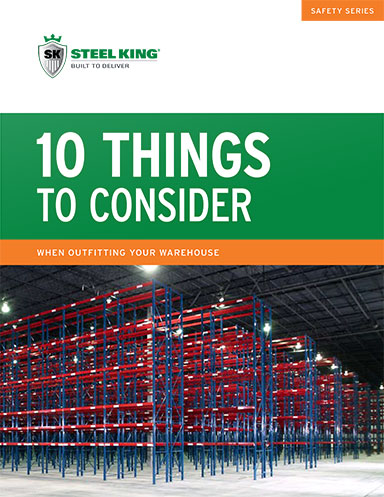Where rack meets automation
Order profiles are changing, and that means your rack should, too.
For just about as long as we’ve had warehouses, companies have used storage rack. It’s the backbone of a facility, and no matter how advanced the surrounding automation and technology, will likely remain so well into the future. But as companies seek greater efficiencies, they’re increasingly adding automation. Ensuring automation integrates with racking—or simply evolving your rack to keep up—is essential to smooth operations.
Those changes often come in the form of order profiles. Where once the bulk of racking was designed to hold pallets, increasingly larger percentages are now dedicated to cases and even eaches.
As the size of the orders goes down, and the SKUs goes up, the pick profile is evolving. “Not only is the profile changing, but it’s changing rapidly,” says Jagan Reddy, managing director of U.S. operations for NetLogistik, “so it’s wise to avoid locking into a fixed infrastructure.”
The result is that many companies are seeking denser storage and increased storage slots. Rather than expanding outward and requiring more square footage, that usually means going up. And because up can mean as high as 150 feet in the case of automated storage and retrieval systems (AS/RS), there’s a need for automation, not humans.
In many ways, increased automation that integrates with storage helps solve one glaring issue in warehousing today: the labor shortage. “Companies have the need to maximize the square footage of a warehouse, and as their operations grow, they need increased labor, which is hard to find,” says Daniel Aguirre, national sales manager with Nucor. “So, density with storage makes sense and becomes more cost efficient.”
Efficiencies with integrated rack and automation include improved inventory management; improved order fulfillment and picking accuracy; reduction in labor costs and human error, and enhanced safety measures for employees. Now is a good time to consider how to bring the two together successfully.
Constant flux
Traditionally, companies could put up fixed rack and forget it, assuming it would do its job for decades to come. And that was true, but as e-commerce entered the picture, racking profiles began to evolve.
From full pallets to cases and now, increasingly, eaches, order profiles drive racking and automation choices. Today, flexibility is the name of the game. “Change is constant today,” says Reddy. “It’s essential to find solutions that can change as your business changes.”
It’s not just your business that changes, however; the standards and tolerances of racking change every few years, as well. “When new standards are issued, not every jurisdiction will adopt them at once,” says Amit Kutumbale, director of engineering at Steel King. “You may not have adopted them for existing racking, but it’s important to keep in mind when designing.”
So too are fire codes, which come into greater play with dense storage systems. The National Fire Protection Association (NFPA) has requirements on how much space exists between pallets and cases; when the gap isn’t large enough, you’ll need to add sprinkler systems within the storage units. A check in with your OEM or integrator while in the design phase is important, as is connecting with your insurance provider on requirements.
When it comes to tolerances, the automation you choose will have impact on what standards and specs are necessary. For instance, when you’re using conventional rack with lift trucks, your tolerance requirements are lower.
“If you’re using automatic guided vehicles (AGVs) to put away a load, you’ll want your beams tighter than the normal deflection criteria,” says Carlos Oliver, CEO at Frazier. “Usually that means following the European FEM specs—we tighten our manufacturing to match those requirements.”
The reason for the stricter specs is that, when loading racks from a lift truck, there’s room for some error because someone has their eyes on the operation. With automation, the beam must be exactly where its schematic says it is, because the device cannot adjust for deviations. Working with an OEM or integrator will help you ensure your racking is ready.
Installation requirements for racking are precise and “unforgiving,” says Oliver. “You’ve got frames, beams, pallet supports and more, and they must be designed specifically to your needs,” he says.

Your rack partner will also assist with other issues that impact high density, tall systems such as AS/RS or crane-assisted racking. “You’ll have to consider both seismic and wind loads if you’re building high,” says Oliver. “You’ll also need to anchor the racking with larger expansion bolts.”
Another factor in racking choices when adding automation is the shape and structure of the steel components. Different forms and tubing will work best with different types of automation.
If you’re dismantling your older racking to make way for new, Aguirre recommends coordinating with your OEM to ensure they can disassemble and even melt down the old to be turned into new.
An array of options
Automation that integrates with rack comes in a variety of options, the most common being cranes and AS/RS, often in combination with static racking. AS/RS uses robotic mechanisms to move goods within your rack system. The systems can retrieve and store pallets without the need for human handling.
Your choices include fully automated or semi-automated, too. AS/RS represents the former, while combinations of shuttle racks or crane loaded racks represent the latter. Another fully automated option is conveyors that connect directly to racks, so your labor force is only interacting with the conveyors.
In other cases, you might combine conveyors with AS/RS to process pallets and smaller loads into and out of racking. Or, “you might operate with a crane to load or unload at the beginning or end of racking,” says Kutumbale. “Or you might use manual racking on the lower levels and automation on top.”
No matter which configuration makes the most sense, the goal and outcome—if executed correctly—is fewer touches, faster processing and improved inventory management. The options are limitless and highly specific to each customer’s requirements. These are all reasons to work closely with your OEM or integrator to map out the best approach. “You’ll need to consider your capacity, the product you’re storing, whether or not you’re in ambient or cold storage,” explains Aguirre.
Increasingly, warehousing automation includes robotics, as well. You might consider AGVs or autonomous mobile robots (AMRs) for bringing goods to person, or vice versa. Ensuring your rack configurations and aisle spacing can accommodate these vehicles is essential.

You also need to consider software integration. If you’ve got a warehouse management system (WMS), can it integrate seamlessly with the automation’s software? Usually, the answer is yes, but if not, you might have to consider software, like a warehouse control system (WCS). This type of package executes the orders from a WMS, ensuring the automation completes its tasks accordingly.
Putting all these pieces together requires a coordinated effort from the automation provider, rack manufacturer, and sometimes an integrator. “When you engineer up front before any implementation, you will be better off down the road and when you kick off your project,” says Aguirre. “It will make the process much more seamless.”
Along those lines, Reddy cautions against getting swept up in the latest and greatest options. “Don’t rush into your racking or tech decisions because someone says a product is innovative,” he says. “Start with your business profile and how it is evolving, how your competitors are evolving, and how customer expectations are evolving.”
This will set you up for future success, too, as the one constant in warehousing is change. “Have a point of view on what’s likely to come in the next 12 months to five years,” says Reddy. “Make decisions based on that, rather than on what the newest automation is.”
One way to potentially buffer against missteps is a pilot project. These can be small-scope test cases that allow you to test the waters. They require far less capital investment than a full-fledged project and provide you with tangible results on which to base your final decisions.
Whether or not designing for a greenfield site or growth within an existing facility, thinking ahead is essential. “Certain designs and heights might maximize your operations today, but what about tomorrow?” asks Aguirre. “Maybe an extra 10 feet of height now will allow you to grow into a larger system later, for instance.”
You might be taking a phased in approach to automation or going all in, but in either case, you’ll have to consider downtime during the transition. How will you work around installation and ensure customer satisfaction?
With a range of options available today, investing in all the upfront work before pulling any triggers for change is the path to success. No matter which configuration you choose for today’s operation, it must include flexibility for tomorrow.
“The industry is changing rapidly, and you cannot afford a big investment in fixed infrastructure,” reminds Reddy. “It will become irrelevant quickly.”













